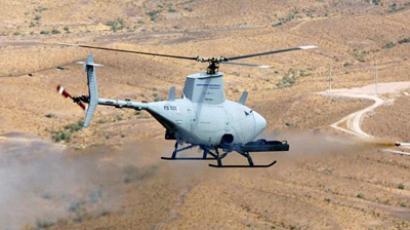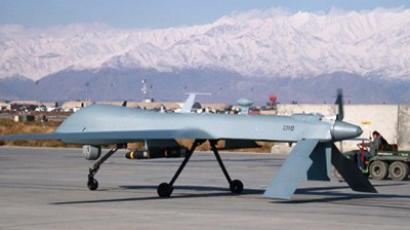Hundreds of slaughtered civilians isn't a 'huge number' for Obama

On Monday afternoon, Barack Obama became the first president to host a virtual town hall live on the Internet.
While that might be a feat worthy of the record books, President Obama did something else during his address that America has become accustomed to: he lied to the world.Speaking Monday during a live web-chat hosted by Google, the president took on a series of issues submitted by the American people. Over the span of 45 minutes, President Obama addressed the Stop Online Piracy Act while refusing to side with either end of the argument, admitted to the world that he isn’t all that swell of a dancer and took a query from a professional puppeteer. In between ignoring the real issues or offering any sort of solid solution to the nation’s biggest problems, the president did put something rather important out for the world to ponder: America’s ongoing drone missions aren’t really all that bad.If you ask anyone outside of the Oval Office — or especially America — they might tell you otherwise.Tackling a question posed on drone strikes, President Obama defended the ongoing missions on Monday, saying they were necessary to target terrorists in a most effective manner. "For us to be able to get them in another way would involve probably a lot more intrusive military action than the ones we're already engaging in,” the president said on the topic of drones. While an argument could easily be made that operating drone missions in lieu of putting boots on the ground is best for the US Armed Forces, the president put a lot on the line Monday when he downplayed the result of the strikes. Those drone attacks, carried out by unmanned aircraft controlled thousands of miles away, don’t do a lot of harm, said the president. According to Obama, drones had "not caused a huge number of civilian casualties” and he added that it’s "important for everybody to understand that this thing is kept on a very tight leash.”How small is that not-so huge number? If you ask anyone outside of the American intelligence community, they’ll tell you it is in the hundreds.But what’s a few hundred civilian deaths, right?Obama suggested that continuing the drone program would not be detrimental to the safety of foreign citizens, but studies conducted outside of the US say otherwise. Last summer, the UK’s Bureau of Investigative Journalism argued that since America began drone strikes, at least 385 civilians had been executed in US-led attacks. Of those statistics, the Bureau added that around half of the dead were children under the age of 18.If you don’t take the word of foreign reporter’s, even American intelligence can confirm that the “not a huge number” statistic might be a bit of an exaggeration. One senior US official speaking on condition of anonymity added to CNN last year that CIA drone strikes had taken the lives of 50 civilians in all. As drone strikes go unreported and deaths unaccounted for, the actual number, unfortunately, is probably much higher than what either the CIA or the Bureau of Investigative Journalism can come up with. In a single strike last March, 26 Pakistanis were killed during a US strike over Islamabad. Once all deaths were accounted for, it was revealed that over a dozen of the deaths in that single raid were suffered by innocent civilians. When the Bureau of Investigative Journalism released their findings last year, they said that the number of civilians killed in US drone strikes were probably 40 percent higher than what the US was actually reporting. Between 2004 and 2011, they put the estimate of civilian deaths at a figure of 385, but added in the research that the toll could actually come close to tallying 775 casualties.Which, if you ask President Obama, is not a huge number.If 775 isn’t a huge number, than 56 is practically a fraction. That’s the number of children executed by US drones in the first 20 months of the Obama administration.“Even one child death from drone missiles or suicide bombings is one child death too many,” responded Unicef to the news at the time.In 2009 alone, almost 600 civilians were killed on the ground in Afghanistan, and the United Nations put 60 percent of that figure as a direct result of airstrikes, drone or otherwise. In Pakistan, civilians say they are terrified of the robotic planes and the damage that they have already done. “There was not a single Taliban militant in Pakistan before 9/11 but since we joined this war, we are facing acts of terrorism, bombing and drone strikes,” Movement for Justice leader Imran Khan told the press in 2011. In Libya, where the United States never even engaged in an official war, according to Obama, American troops launched 145 drone strikes in an attempt to oust the regime of Muammar Gaddafi in a matter of months. As with most drone missions, the Department of Defense has not released any official statistics on what casualties were caused by the strikes. Regardless of what damage a drone strike can have on enemy insurgents, experts say that the toll visited on civilians is several times that of militants. In a 2009 report from the Brookings Institute, Senior Fellow Daniel L Byman wrote that “for every militant killed, 10 or so civilians also died.”In Pakistan where drone strikes have become practically commonplace, civilians are terrified that they will become the next accidental target of American aircraft. Saadullah, a teenage boy who spoke with a BBC reporter last year, lost both of his legs in drone strikes. Three of his relatives, all civilians, have also been killed by American strikes. Asghar Khan, an elder in Islamabad that also spoke to BBC, said three of his relatives were also shot down in airstrikes."My brother, my nephew and another relative were killed by a drone in 2008," said Khan. "They were sitting with this sick man when the attack took place. There were no Taliban."A decade after the US began so-called cooperation with Pakistani intelligence, anti-American sentiments continue to grow as do the number of casualties. "When we intervene in people's countries to chase small cells of bad guys, we end up alienating the whole country and turning them against us,” counterterrorism expert David Kilcullen tells the Brookings Institute. Now as the US puts surveillance drones over the skies of Iraq even after that war has officially ended, yet another country is becoming concerned that drones will drop bombs on their own civilians. “We hear from time to time that drone aircraft have killed half a village in Pakistan and Afghanistan under the pretext of pursuing terrorists,” 37-year-old café owner Hisham Mohammed Salah told the New York Times just this week. “Our fear is that will happen in Iraq under a different pretext.”Under the Pentagon’s new revised budget, the US will phase out around 100,000 military staffers while adding droves of drones to its already established arsenal of robotic planes. Will drones soon become the United States’ not-so-secret weapon and phase out its Armed Forces personnel entirely? It’s not out of the question. After all, a drone strike authorized by Obama last year led to the death of two American citizens with alleged terrorist ties.Don’t worry, though. Obama says these things are kept on a tight leash. Who actually pulls on that is as good of a guess as anyone’s, though. In November, the Wall Street Journal wrote that the “signature” strikes that account for most of the CIA’s drone missions only end up on the desk of the president after they are carried out. The US must only inform Pakistan of those strikes, by the way, if they believe the death toll will exceed 20. Which really isn’t that big of a number either.














